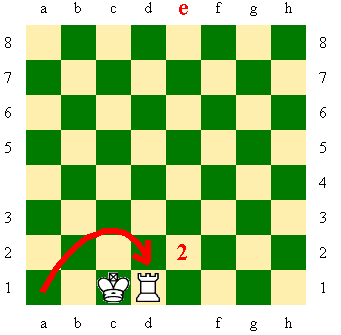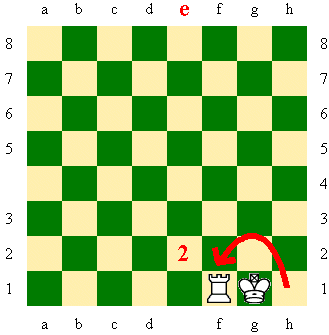|
Now we've REALLY seen how each piece on the board moves. But we're still not done learning how the pieces move, as there a few special moves that some of the pieces can make that are out of the ordinary. The first one we're going to look at is castling, and to do that, we're going to first set up the pieces in the initial starting position and look at a common opening move sequence. |
Okay, we've seen kingside castling before. And yes, there's a queenside castling (castling in the opposite direction with the other rook) as well. So lets look at the particulars of castling. We'll set up a king and a rook on the board by themselves.
Here we have the king and rook sitting on their original squares, the same as when you first set up the pieces. Castling involves two steps and two pieces. (Its the only move in chess where you'll get to move two of your pieces at one time!) We'll move the king first, and then the rook. (Which is how you should do it, as well. In fact, when you play tournaments its a RULE that you must move the king first, and then the rook, in order to castle.) |
The first half of castling involves moving the king:
|
Step 1: The white king moves TWO squares towards the rook with which it intends to castle. This is the only time in the game a king gets to move more than one square at a time. |
And for the second half of the move, the rook goes around to the other side.
|
|
Step 2:
The rook hops over the king and takes its place on the other side of His
Majesty, sitting on the square right next to him.
|
Now we've gone over kingside castling, which involves the king and the rook nearest to it on the right side of the board. But you've got two rooks, haven't you? The other rook is on what we call the 'queenside' of the board, and there is such a thing as queenside castling, with the king and the rook on the lefthand side (the 'queenside') of the board. Lets look at that.
|
Queenside castling is a little different, but not much. The only difference is the rook moves a little farther in queenside castling. |
First we move the king:
|
Step 1: As before, the king starts off the dance by moving two squares, but this time he's moving two squares to the left, rather than two squares to the right. |
Care to take a guess, now, as to where the rook will move to complete the move?
 |
Step 2: That's right. The queenside rook (which can be called the 'queen rook') moves to the opposite side of the king to sit on the square right next to it. |
Basically, that's it. Basically.... Yes, there are some other rules to castling that control not so much as how you can castle, but whether if you can castle at all or not. (Yeah, I know, there're always rules....) We'll go over them here:
Here, for some reason that only he knows, white just moved his king forward to square 'e2'. White had not previously castled, and that's too bad, because now white can NEVER castle, because he's already moved his king once. Even if he moves his king back to square 'e1', he still can't castle becuse he's already moved his king. Black in this position hasn't moved his king yet, and can now go ahead and castle on the kingside, thereby safeguarding his king and bring his rook into play. So, if you want to castle, don't move your king beforehand. On the other hand, if you don't want your opponent to castle, try and force him to move HIS king! |
Okay, we can't move the king before castling, how about the rooks?
In this position, white moved his king rook from square 'h1' to 'h2'. Now white can never castle on the kingside with this rook again, EVEN IF HE MOVES THE ROOK BACK TO 'h1'. Sorry, its too late. (Black as we can see has already castled on HIS kingside, however.) But all is not lost. Because the king has not yet moved, and the QUEENSIDE ROOK ALSO HAS NOT MOVED, white CAN STILL castle on the queenside. So if you can't get your opponent to move his king early on, maybe you can get him to move one or both of his rooks. (But that's really hard, and you've got better things to do anyway in the opening, as we'll see later on.) |
Now, even if you haven't moved your king and rooks yet, there still might be reasons why you can't castle:
(Sorry, they just didn't think it was very sporting for you to be able to escape all your problems by castling out of check.) Here, black has just moved his bishop to square 'b4' and placed white's king into check. With his king in check, white now CANNOT castle. But he IS in check, so he's got to drop everything he's doing and get out of check, either by moving his king or (think about THIS!) moving another of his own pieces into the path of the attacking bishop, such as moving the pawn on square 'c2' ahead one square to 'c3'. Set it up on a board yourself to see what it looks like. Rule 4: You cannot castle into check. And let's look at black's castling chances. Here, black can't castle on his kingside because the first half of the castling move (taking the black king and moving two squares over from 'e8' to 'g8' where the red 'X' is) would place the king into check from white's bishop on square 'c4'. (Follow the arrows from the bishop to the 'X' on 'g8' to see what I mean.) Simply stated, you can't move your king into check, even if you're castling. The king's just too important for that. (There's no reason in the world, however, why black can't castle queenside in this position, once its his move again.) |
And there's one more consideration to when you can and can't castle:
Huh? Okay, what I mean is that if the the castling move takes the king across a square that is covered by your opponent's piece, then you cannot castle. I know; your king is just passing through, but it doesn't matter. The king is so important, it can't even pass over a square that's covered by an enemy piece. It's easier to visualize than describe. Here, white cannot castle to his queenside because the king would have to move over square 'd1' (where the red 'X' is) on its way to 'c1'. Square 'd1' is covered by the black bishop on 'g4'. (Follow the arrows from the black bishop on g4 to the 'X' on 'd1'.) The king would be castling through check, and that's not allowed. White CAN castle to his right in this position, though, over to the kingside. Similarly, black cannot castle kingside in this position, because square 'f8' over which the king would pass is covered by the white bishop on 'b4'. (Follow the arrows to the red 'X'.) There would be no problem, however, with black choosing to castle queenside in this position, ending up on square c8. |
Oh, by the way, there's one more thing. If you've castled once already, and just happen to get your king back to its original square later on in the game, don't think that you can castle again with the other rook that's still sitting on its own square on the other side of the board. You can't. Sorry. One per customer per game, please.
So, that's castling. The move itself is simple, and there's some additional rules that control it. As you play more games, you'll get the hang of it to where it'll be second nature.
